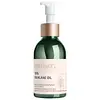What's inside
What's inside
 Key Ingredients
Key Ingredients

No key ingredients
 Benefits
Benefits

 Concerns
Concerns

No concerns
 Ingredients Side-by-side
Ingredients Side-by-side

Caprylic/Capric Triglyceride
MaskingCamellia Japonica Seed Oil
EmollientSqualane
EmollientIsostearyl Isostearate
EmollientDicaprylyl Ether
EmollientTriheptanoin
Skin ConditioningParfum
MaskingPolyglyceryl-10 Pentaisostearate
EmollientOryza Sativa Germ Oil
EmollientPhytosteryl Macadamiate
Skin ConditioningSaccharomyces/Rice Ferment Filtrate
Skin ConditioningCamellia Sinensis Leaf Extract
AntimicrobialCladosiphon Okamuranus Extract
Skin ConditioningOryzanol
Skin ConditioningGold
Cosmetic ColorantTocopherol
AntioxidantPropanediol
SolventDimer Dilinoleyl Dimer Dilinoleate
EmollientStearyl Glycyrrhetinate
Skin ConditioningEthylhexylglycerin
Skin ConditioningPhenoxyethanol
PreservativeCitral
PerfumingLimonene
PerfumingLinalool
PerfumingCaprylic/Capric Triglyceride, Camellia Japonica Seed Oil, Squalane, Isostearyl Isostearate, Dicaprylyl Ether, Triheptanoin, Parfum, Polyglyceryl-10 Pentaisostearate, Oryza Sativa Germ Oil, Phytosteryl Macadamiate, Saccharomyces/Rice Ferment Filtrate, Camellia Sinensis Leaf Extract, Cladosiphon Okamuranus Extract, Oryzanol, Gold, Tocopherol, Propanediol, Dimer Dilinoleyl Dimer Dilinoleate, Stearyl Glycyrrhetinate, Ethylhexylglycerin, Phenoxyethanol, Citral, Limonene, Linalool
 Reviews
Reviews

Ingredients Explained
These ingredients are found in both products.
Ingredients higher up in an ingredient list are typically present in a larger amount.
Squalane is an emollient that helps the skin hold onto moisture. It's an oily liquid that occurs naturally in certain types of fish and plant oils.
Because squalane boosts hydration in the skin, it also comes with plenty of benefits: it is an antioxidant and can help fight free radicals and skin damage. Squalane is also found to have a detoxifying effect when applied.
Squalane comes from squalene, which occurs naturally within the sebum of our skin. It is one of the oils our skin produces to keep itself hydrated. Squalane is the hydrogenated version of squalene and has a longer shelf life.
Research shows that squalane is non-irritating (even at 100% concentration).
In general, it's a fantastic ingredient. It does a great job at hydrating the skin, and it's suitable for those with sensitive skin.
The source of squalane may impact malassezia / fungal acne. This is because olive oil derived squalane can contain impurities such as fatty acids and plant waxes. Sugarcane derived squalane is recommended for anyone with malassezia concerns.
Is squalane vegan?
This depends on the source. Squalane can be derived from both plants and animals. Most squalane used in skincare comes from plants.
Please note: the source of squalane is only known if disclosed by the brand. We recommend reaching out to the brand if you have any questions about their squalane.
Read more about squalene with an "e".
Is squalane an oil?
Squalane is often called an oil, but it’s technically not; it’s a hydrocarbon, meaning it’s only made of carbon and hydrogen, unlike true oils which are triglycerides made of fatty acids and glycerol.
The term “oil-free” isn’t regulated, so companies can define it however they want. Some exclude all oils, while others just avoid mineral oil or comedogenic oils.
While some people avoid oils thinking they cause breakouts, the right kind of oil (or oil-like ingredient like squalane) can actually help balance and hydrate your skin. It’s worth testing out simple oils or squalane to see what works best for your skin.
Learn more about Squalane